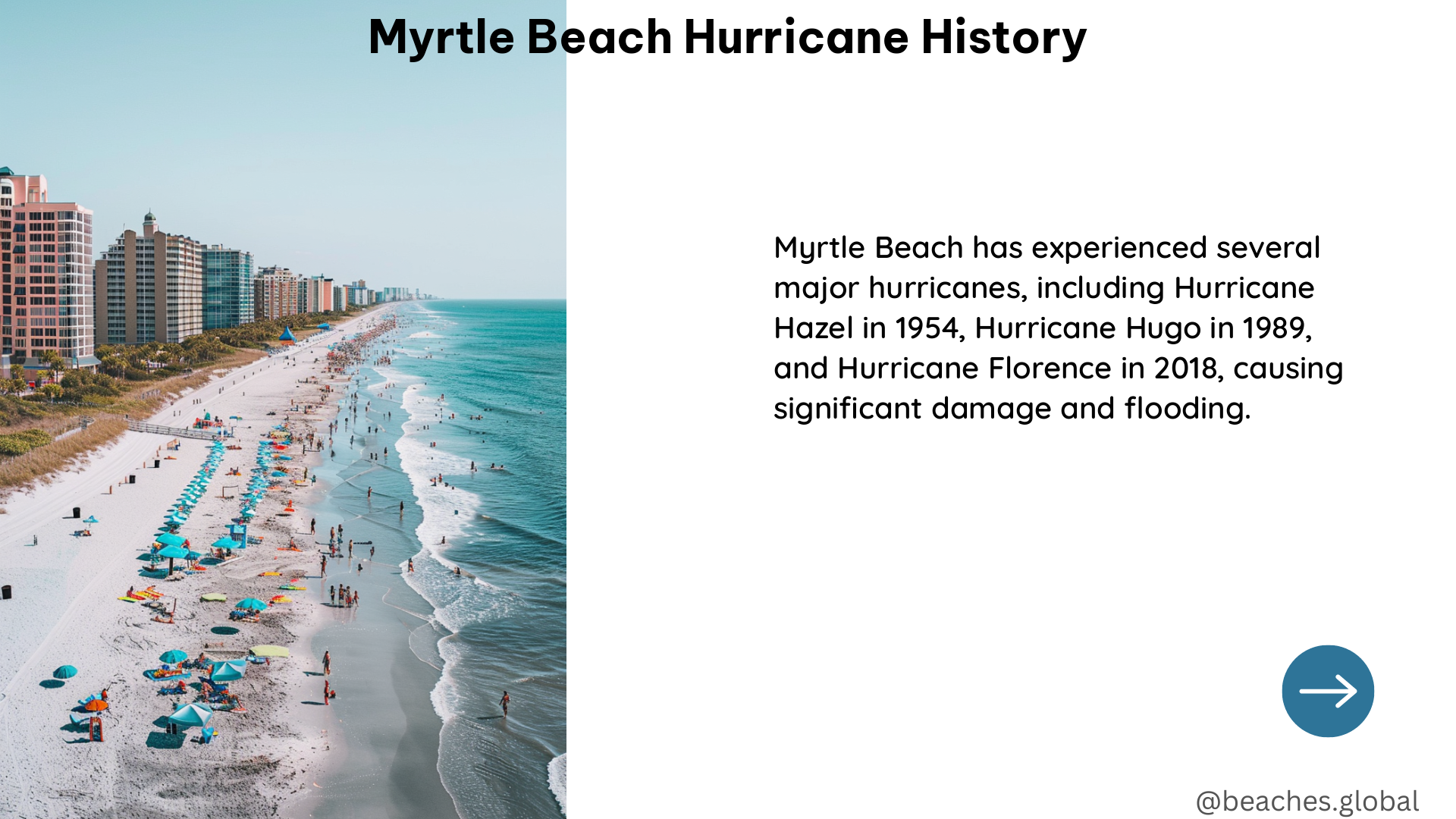Myrtle Beach, a beloved coastal destination in South Carolina, has a rich and turbulent history when it comes to hurricanes. Over the past century and a half, the area has weathered several significant storms, each leaving its mark on the community. In this comprehensive guide, we’ll delve into the details of these hurricanes, exploring their dates, categories, landfall locations, and the damages they caused.
The Devastating Storms that Shaped Myrtle Beach
The Sea Islands Hurricane of 1893
This unnamed hurricane made landfall on August 28, 1893, near Ossabaw Island, Georgia, and moved into South Carolina. It created an enormous storm surge that submerged many of the Sea Islands, causing at least 2,000 deaths and $334.1 million in damage (inflation-adjusted to 2023). This was the first of two major hurricanes to affect South Carolina in 1893.
The 1893 Charleston Hurricane
This Category 3 storm made landfall near McClellanville on October 18, 1893, causing more extensive damage in the Palmetto State. When it made landfall at Awendaw, it was a Category 2, with winds estimated at 105 mph. It crawled to the northwest over eastern South Carolina, resulting in record rainfall, widespread flooding, and $10 million in damages (inflation-adjusted to 2023).
Hurricane Hazel (1954)
On October 15, 1954, Hurricane Hazel made landfall on the border between South Carolina and North Carolina as a Category 4 hurricane. Almost 80% of all waterfront dwellings were destroyed during this hurricane, and many low-lying barrier islands were completely flooded. The official report from the area Weather Bureau stated: “all traces of civilization on the immediate waterfront between the state line and Cape Fear were practically annihilated”.
Hurricane Gracie (1959)
Hurricane Gracie made landfall on August 21, 1959, as a Category 4 storm in St. Helena Sound, causing extensive waterfront damage, tremendous storm surges, and leaving telephone poles askew and many feet of sand covering roadways. This storm was so severe that at one point, the Weather Bureau reported about 3,000 tornadoes embedded within the hurricane, which was to blame for much of the damage.
Hurricane Hugo (1989)
On September 22, 1989, Hurricane Hugo made landfall in South Carolina as a Category 4 hurricane, claiming the lives of 27 South Carolinians and causing extensive waterfront damage, tremendous storm surges, and leaving telephone poles askew and many feet of sand covering roadways. This storm was so severe that at one point, the Weather Bureau reported about 3,000 tornadoes embedded within the hurricane, which was to blame for much of the damage.
Hurricane Irene (2011)
The most recent hurricane that came close to Myrtle Beach was Hurricane Irene on August 23, 2011. Myrtle Beach did receive its share of tropical storm-force winds, with branches and older trees falling and some low flooding being some of the worst of the damage.
These hurricanes have significantly impacted Myrtle Beach, causing widespread destruction, loss of life, and extensive economic damage. As the peak hurricane season passes, it is crucial to remain vigilant and prepared for potential storms.
Myrtle Beach’s Resilience in the Face of Hurricanes

Myrtle Beach has a long history of weathering powerful hurricanes, and the community has demonstrated remarkable resilience in the face of these natural disasters. Despite the devastation caused by storms like Hazel, Gracie, and Hugo, the city has consistently bounced back, rebuilding and strengthening its infrastructure to better withstand future hurricanes.
One of the key factors in Myrtle Beach’s resilience is its commitment to disaster preparedness. The city has implemented comprehensive emergency management plans, which include early warning systems, evacuation procedures, and coordinated response efforts. Additionally, the local government has worked closely with state and federal agencies to secure funding for infrastructure improvements, such as reinforcing seawalls, elevating roads, and upgrading drainage systems.
Another important aspect of Myrtle Beach’s resilience is the community’s spirit of cooperation and mutual support. During and after hurricanes, residents have come together to assist one another, volunteering their time and resources to aid in the recovery process. This sense of community has been instrumental in helping the city bounce back from even the most devastating storms.
Preparing for the Future: Myrtle Beach’s Ongoing Efforts
As the effects of climate change continue to impact coastal regions, Myrtle Beach is taking proactive steps to prepare for the future. The city is investing in cutting-edge weather monitoring and forecasting technologies, which allow for more accurate predictions and earlier warnings of approaching storms.
Additionally, Myrtle Beach is exploring innovative strategies to mitigate the impact of hurricanes, such as the use of natural barriers like wetlands and dunes to absorb storm surges. The city is also working to promote sustainable development practices, ensuring that new construction is designed to withstand the rigors of hurricane season.
By staying vigilant, investing in resilient infrastructure, and fostering a strong sense of community, Myrtle Beach is positioning itself to weather the storms of the future with the same determination and resilience that has defined its past.
References:
– South Carolina Department of Natural Resources: South Carolina Hurricanes Executive Summary
– Myrtle Beach Online: Myrtle Beach Hurricane History
– Ocean Front Vacation Rentals: Myrtle Beach Hurricane History
– WBTW News: Major Hurricanes to Hit Grand Strand Since 1893
